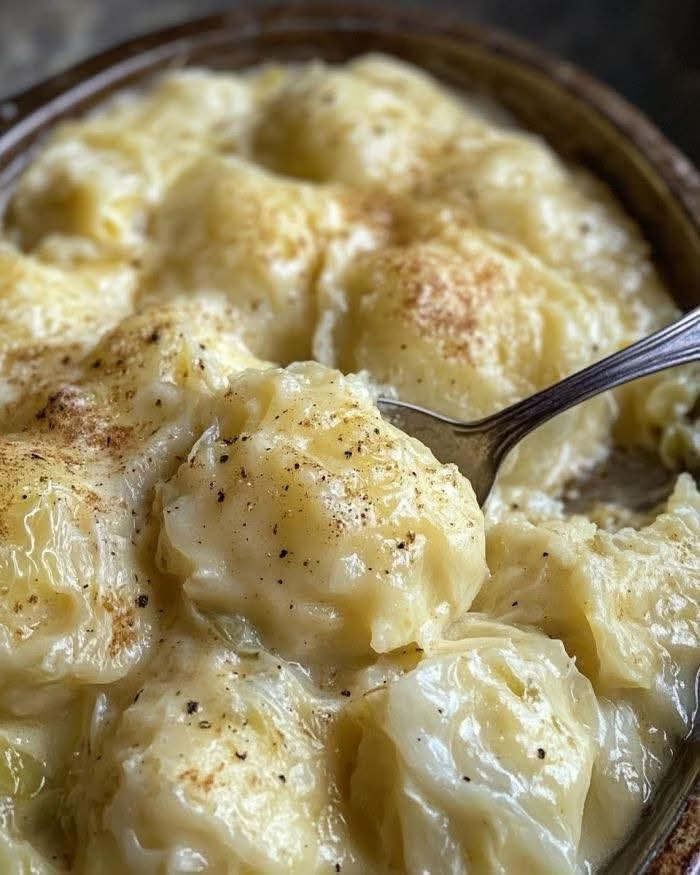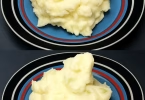Authentic German Cabbage and Dumplings
German cuisine is renowned for its rustic simplicity and rich, earthy flavors, and few dishes capture that spirit better than Cabbage and Dumplings. This heartwarming recipe, rooted in centuries-old traditions, is a classic example of how humble ingredients—like cabbage, flour, and eggs—can come together to create a dish that’s deeply comforting, nutritious, and utterly delicious.
The Story Behind the Dish
This dish has been passed down through generations of German families. Originally crafted in rural kitchens where ingredients were limited and nothing went to waste, **cabbage and dumplings** became a staple on cold winter nights. The cabbage, often harvested and stored for the long months ahead, was braised slowly for sweetness and softness. The dumplings, made from flour and eggs, were dropped right into the pot—a one-pan solution for feeding large families without fancy ingredients.
Today, it’s still served at **Oktoberfest celebrations**, weeknight dinners, and festive family gatherings. Whether you’re looking to explore traditional European flavors or simply want to enjoy a soul-satisfying meal, this dish is a delicious place to start.
Ingredients and Their Roles
For the Braised Cabbage
- 1 medium green cabbage, shredded: The hero of this dish. When braised, cabbage becomes tender and slightly sweet, absorbing the flavors around it beautifully.
- 3 tablespoons unsalted butter or bacon drippings: Butter brings richness, while bacon drippings add a smoky depth that gives the dish an unmistakable old-world flavor.
- 1 onion, finely chopped: Onions form the aromatic foundation, adding subtle sweetness and depth.
- 2 garlic cloves, minced: Garlic elevates the savory notes and rounds out the flavor profile.
- ½ teaspoon caraway seeds (optional): A traditional German spice that pairs naturally with cabbage. Earthy, slightly peppery, and aromatic.
- 1 cup chicken or vegetable broth: The braising liquid that brings moisture and flavor. Choose vegetable broth for a vegetarian version.
- 2 tablespoons apple cider vinegar: Adds brightness and helps balance the richness of the dumplings and butter.
- Salt and black pepper, to taste: Never underestimate the power of good seasoning—vital for unlocking all the layers of flavor.
For the Dumplings
- 2 cups all-purpose flour: The base structure of our dumplings, forming the foundation for that light, fluffy texture.
- 2 teaspoons baking powder: Essential for lift and fluffiness, creating soft, pillowy dumplings.
- ½ teaspoon salt: Enhances the flavor of the dough and balances the richness of the butter and eggs.
- 2 large eggs: Add richness and act as a binder to hold the dough together.
- ½ cup milk (plus more if needed): Provides moisture and helps the dough come together smoothly.
- 2 tablespoons butter, melted: Adds tenderness and a luxurious buttery flavor that permeates the dumplings.
How to Make German Cabbage and Dumplings
Step 1: Sauté the Aromatics
In a large heavy-bottomed pot or Dutch oven, melt the butter or bacon drippings over medium heat. Add the onions and cook for about 3–4 minutes until softened. Stir in the garlic and sauté for another 30 seconds until fragrant.
Step 2: Braise the Cabbage
Add the shredded cabbage to the pot and sauté for 5–7 minutes until it begins to wilt. Sprinkle with caraway seeds, season with salt and pepper, and stir to coat. Pour in the broth and apple cider vinegar. Cover the pot and let simmer over low heat for 20 minutes, stirring occasionally, until the cabbage is tender and flavorful.
Step 3: Prepare the Dumpling Dough
While the cabbage is braising, whisk together the flour, baking powder, and salt in a mixing bowl. In a separate bowl, beat the eggs with the milk and melted butter. Combine the wet and dry ingredients and stir until a soft dough forms. If the mixture is too thick, add an extra splash of milk.
Step 4: Cook the Dumplings
Once the cabbage is soft and simmering gently, use a spoon to drop dollops of the dumpling dough on top of the mixture. Cover the pot tightly and let cook undisturbed for 12–15 minutes. The steam will cook the dumplings through, making them light and fluffy. Avoid lifting the lid during cooking, as that releases the steam needed to cook the dumplings properly.
Step 5: Serve and Enjoy
Spoon the tender cabbage and plump dumplings into bowls. The result is pure comfort—savory, slightly sweet cabbage paired with cloud-like dumplings.
Why This Recipe Is So Loved
This is the kind of recipe that tastes like home, whether or not you grew up eating it. It’s humble and affordable, yet deeply satisfying. The texture contrast between soft cabbage and fluffy dumplings is comforting and hearty. And it’s versatile—you can enjoy it as a vegetarian main, or pair it with sausage or pork to make it a full meal. No wonder it’s been cherished for generations.
Expert Tips for Success
- Use a large, wide pot so the dumplings have enough room to expand.
- Don’t overcrowd the dumplings. Leave a little space between spoonfuls to avoid sticking.
- For smoky depth, go with bacon drippings instead of butter when sautéing the onion and cabbage.
- Add sausage links or smoked pork chops to make this dish even more robust.
- Use leftover cabbage and broth as a flavorful soup base the next day.
Serving Suggestions
This dish is a complete meal on its own, but if you’re looking to round out the experience, here are some delicious pairings:
- Grilled Bratwurst: Classic pairing that turns this into a Bavarian feast.
- German Mustard and Sauerkraut: Add tang and zing to balance the richness.
- Dark Rye Bread or Pretzels: Great for sopping up the flavorful cabbage juices.
- Apple Strudel or Black Forest Cake: Finish your meal with a sweet German dessert.
Make It Ahead
Both the cabbage and the dumpling dough can be prepped ahead of time. Store the cooked cabbage in the refrigerator for up to 3 days, and mix the dumpling dough just before reheating the cabbage. It also freezes well—simply thaw and reheat gently on the stove.







